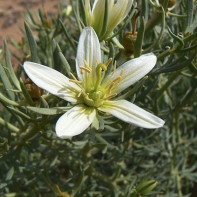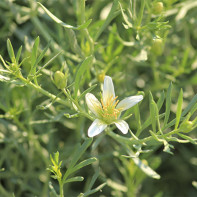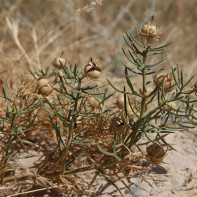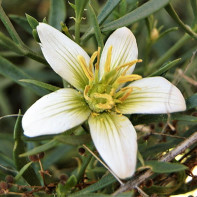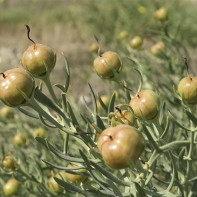Garmala: medicinal properties and contraindications
The medicinal plant, which botanists called the common harmala, bears several more popular names, sometimes very disrespectful. It is called wild or mountain rue, pigan, dog shit, arrowhead, bibika. But the most “outstanding” names are grave grass or burial ground. Despite the fact that harmala is poisonous, it has so many useful properties that, when used correctly, it fully reveals its healing qualities.
- Chemical composition
- How it looks and where it grows
- Collection and storage
- The healing properties of harmonica
- Garmala vulgaris in folk medicine
- From colds and rheumatism
- From diseases of the digestive system
- Soothing broth
- Tea for kidney disease
- Bath Composition
- For shortness of breath and asthma
- Garmala aphrodisiac
- From inflammation of the sciatic nerve
- For joint pain
- Smoke fumigation
- With a snakebite
- Types of healing compounds
- Infusion
- Tincture
- Decoction
- Butter
- Contraindications
Chemical composition
Garmala is poisonous because it contains a large number of alkaloids, primarily harmaline, harmine and peganin. These are the main active ingredients of the plant.

A significant part of the harmine (its second name is banisterin) is located in the roots, and young plants are much richer in this substance than old ones. Garmalin predominates in seeds, and peganin in the grassy, green part of the plant. Moreover, the highest concentration of alkaloids is concentrated in the seeds, here their content can reach 9%.
Thanks to the complex of alkaloids, harmala relaxes smooth and striated muscles, that is, it has a muscle relaxant effect.
In small doses, harmaline is able to excite the nervous system and activate the work of motor centers in the brain. In the list of his actions - stimulation of the muscles of the uterus, the expansion of peripheral blood vessels, which helps to reduce pressure and normalize heart rhythm. But in large quantities, this alkaloid is extremely toxic and deadly.
Peganin and Harmin have a relaxing effect on the muscles of a number of organs - such as the uterus, heart, and intestines. Garmin has less toxicity than peganin, however, and it can provoke seizures. Peganin can act on the bronchial wall, relaxing it, which makes it possible to use it for bronchial asthma.
The harmala also includes the peganidin alkaloid (it is found in the green parts of the plant), it has a bactericidal and anti-staphylococcal effect.
Chemists have isolated a number of alkaloids from the plant, all of them are, to varying degrees, relatives of harmine and peganin and are found in small quantities.
Seeds also contain fatty oil, which healers specifically extract and collect. In addition, it is rich in harmony with protein and a number of other useful substances. These are carotenoids endowed with antioxidant activity, steroids involved in building muscle mass, regulating cholesterol levels and strengthening the immune system of saponins.
In the green part of the plant, a significant amount of micro and macro elements: potassium, magnesium, iron, aluminum, copper, zinc, strontium, manganese, chromium, nickel, lead. Once in the human body, these components are involved in almost all life processes.
How it looks and where it grows
Garmala is a very lively plant, this is evidenced by its root - strong, many-headed, going into the ground in search of moisture to a depth of at least 3 m.This powerful root nourishes the aboveground part, growing in height from 30 to 80 cm.
Due to branched stems, which can be formed from more than 100 pieces from one root, the plant has a neat spherical shape. The stems themselves are mostly bare and randomly confused, and the leaves covering them are cut into 3-5 narrow and pointed lobes. They sit on a green stalk in turn, attaching to very short petioles.
The plant blooms from May to July with yellow or white flowers, which can grow both individually at the end of the branch, and 3 pieces at a time. A five-petalled flower cup would resemble a bell if it were not cut to the very base of the petals. The length of each petal is up to 2 cm.
When blooming, harmala forms a rather large and noticeable fruit, its diameter from 6 to 10 mm. Because of this, the fruits cannot be confused with any other plant. This is a box in the form of a flattened ball, consisting of three lobes-nests, between which there are partitions. In each nest lies a trihedral brown or gray-brown seed from 3 to 4 mm in size. Seeds ripen from the end of July, and each bush can give them up to 120 thousand.
Garmala has a characteristic strong recognizable smell, which is why it was called the "burial ground". It looks like the smell of wormwood, but not as choking.
Originally from Asia, this plant is a weed that tolerates drought, so it feels great on moisture-poor soils in Jordan, Pakistan, and India. Its element is wastelands near populated areas, abandoned cemeteries and old abandoned pastures where harmala is able to form continuous thickets. Oases in deserts, steppes, rocky foothills - it will take root everywhere.
In Russia, it can be found in the southern regions of the European part of the country, as well as in the steppe territories of Western Siberia. In neighboring countries, harmala has lived in a number of regions of Ukraine, all the territories of Central Asia.
Collection and storage
For medicinal purposes, use all parts of the plant - the root, stems with leaves and flowers and seeds. Moreover, eastern healers are sure that it is better to go to the desert for harmal, and not to the foothills, because there it accumulates more healing substances.
Roots are best harvested from May to mid-July. Younger specimens are preferred, since they have more alkaloids. They are dug up, washed well and dried in the sun. Store more conveniently in cut form. The next time in this territory the roots are dug up only after three years. Otherwise, the population will not recover.
Seeds are harvested when they begin to ripen, and the bolls are about to open, that is, from the end of July and in August. The grass is collected in sheaves, dried and then threshed to separate the seeds. After drying in a draft, they are stored in cotton bags or paper bags.
And the aboveground part - the greens - is collected twice, at different times. They begin in April, when the harmony is most of all peganin alkaloid. As the plant develops, the amount of peganin decreases, but the concentration of harmine increases. And herbalists go to harvest raw materials a second time, in May. The April and May harmonica are dried and stored separately from each other, in order to then use the beneficial properties to the maximum. However, you need to have time to collect grass at the time of flowering, before the formation of the fruit.
To harvest grass, use a sharp sickle. The green part of the plant is cut off 15 cm from the soil surface, dried, laying out on clean paper with a layer of not more than 8-10 cm with good weathering under a canopy or in the attic. Dried grass is cut into 6-8-centimeter pieces and put into storage in a dry room, packed in paper bags. The plant does not lose its beneficial properties within 2 years.
Cutting grass on the same site can be carried out with an interval of 2 years, during which time the harmala will have time to restore its thickets.
Harvesting the plant, you need to do everything quickly, clearly and carefully to reduce the time of contact with it in order to avoid headache and nausea.
The healing properties of harmonica
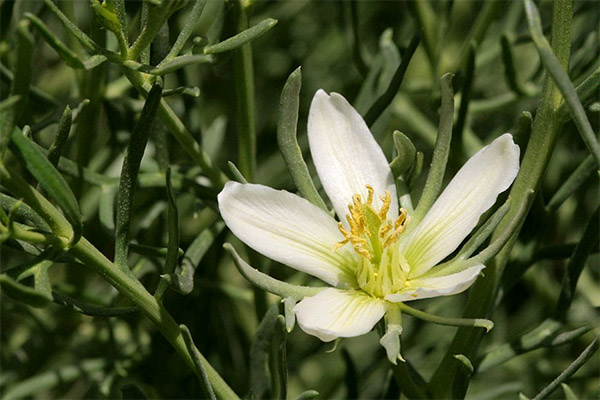
- The chemical composition of harmala determines its use as a means that can stimulate the nervous system and at the same time calm, fight infection and anesthetize, remove inflammation and stimulate perspiration, increase the volume of fluid removed from the body and destroy helminths. However, in Russia, official medicine does not use harmonal preparations, it is still being studied by biologists and doctors, and therefore there is no such drug in the Russian Pharmacopoeia.
- In the territory of African and Asian states and in a number of European countries, this plant is used in public clinics. In neighboring countries of Central Asia with Russia, compressed harmala is even sold in pharmacies, it looks like pencils. And in Yemen, her drugs are recommended for those suffering from depression. Infusions of leaves treat neurasthenia, relieve renal diseases and periodontal disease.
- In Afghanistan, patients with paralysis are fumigated with the smoke of this plant and compresses made from green plants are applied to the tumor sites. Fumigation is also a common procedure in India. But there they set the seeds on fire and open, hard-healing wounds heal with their smoke. Another country where fumigation is used is Uzbekistan. During a flu epidemic, garmalas treat rooms with smoke, thus disinfecting them. Most often, for fumigation, take the dry top of the bush with seed boxes. Dry leaves are also used, but much less frequently. When set on fire, dry raw materials smell like good tobacco, but do not eat eyes, unlike the smoke of other medicinal plants.
- Compounds with harmala are also prescribed for inflammatory diseases of the peripheral nervous system - neuritis, moreover, both mononeuritis, affecting single nerves, and polyneuritis, which are more widespread. A medicinal plant stimulates the work of the muscular system and improves nerve conduction.
- Foreign doctors also use the ability of the components of this medicinal plant - the alkaloids of garmin and peganin - to treat pathologies of the central nervous system - for example, Parkinson's disease or trembling paralysis.
- In a number of eastern clinics, the ability of the alkaloids that make up the harmala to use heavy addiction to cocaine and heroin is used.
- The use of a medicinal plant is based on its medicinal properties. So, in addition to the fact that harmin is a good antidepressant, it also knows how to lower blood pressure and fight Koch's wand, the causative agent of tuberculosis. Peganidin not only fights against staphylococcal infection, but also pushes the heart muscle and activates the formation of bile. The alkaloid vasicin is a mild laxative, and also relieves bronchospasm, which makes it possible to use it to treat asthma.
- Garmala endowed decoctions, infusions, tinctures and other compounds with the ability to anesthetize, soothe.
- Digestive system problems, expulsion of worms, relief of patients with measles, chickenpox and malaria - these problems are also solved with the help of harmonica in several countries of the world. In India, infusions of harmal stimulate uterine contractions for abortion.
- The antiseptic properties of the medicinal plant are used for fever, colds, and also for gargling with tonsillitis and the oral cavity for gum disease.
- Fresh plant juice is instilled into the eyes, treating cataracts in the initial stages. Caucasian healers are sure that in this way the cataract resolves. And to improve vision, medicinal raw materials are mixed with other ingredients - for example, honey or wine.
- Widely used baths with broth harmal. They can relieve pain and reduce inflammation in rheumatism. Baths are also recommended for the treatment of scabies, dermatitis and other skin diseases.
- Traditional healers in Russia use grass to relieve patients from chronic constipation, to improve bowel function and remove its atony. In gynecology, harmala is used to treat mastopathy and menstrual irregularities.
Garmala vulgaris in folk medicine
Doctors can often recommend different dosage forms prepared from a medicinal plant for the treatment of one ailment. But still there are a number of traditional purposes.So, to soothe the pain and remove the swelling in the diseased joints, apply steamed harmal leaves. Decoctions are used as rinses for sore throat, stomatitis or inflamed gums, as well as if a tooth aches.
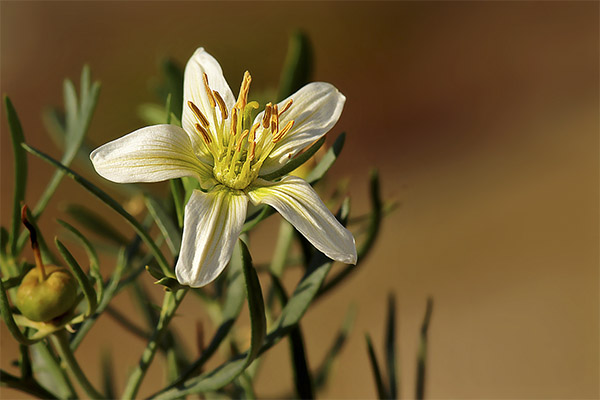
Depression is removed with tea, the teak of the facial nerve is heated with hot broth or lubricated with fresh juice. The same juice is dripped into the eyes with cataracts, and the seeds are prescribed as an anthelmintic. Powdered seeds with honey are recommended for those who often suffer from headaches and who have hair loss.
Even cosmetic problems are solved with the help of harmonica. So, seeds previously soaked in warm water get rid of gray hair at its first manifestations, for which they are mixed with shampoo and then they wash their hair with this mixture. In addition, the seeds can form a foam, so they are washed to prevent the formation of blackheads and acne. And to cure acne that has already appeared, they prepare a tincture of seeds on vodka and then rub it on her face in the evenings.
From colds and rheumatism
The infusion prepared according to this recipe can be used to treat various diseases. Depending on the purpose, a different dosage is used. An infusion is prepared on the basis of a glass of boiling water and a tablespoon of dry harmonica. Insist hour, then strain.
To alleviate the symptoms of a cold, a tablespoon of the remedy is prescribed 20 minutes before breakfast, lunch and dinner.
Rheumatism, myopathy and myasthenia gravis are treated with three times a day infusion - 20-50 ml per dose, and treatment is started with a small dose, gradually increasing to the maximum.
With syphilis, treatment also begins with a small dose - 2 tablespoons, gradually increasing to 5 tablespoons from 2 to 3 times a day.
From diseases of the digestive system
As a choleretic agent, for the recovery of the digestive system and getting rid of helminths, seed intake is indicated. The norm - 10 fruits per day - divided into 2 doses. Drink with boiled water. After 3-4 days, the effect will be noticeable.
Soothing broth
This decoction is called sedative, but in fact it soothes not only the nervous system, but also rheumatic pains, shortness of breath, relieves asthmatic syndrome, and also has a diaphoretic, choleretic and diuretic effect.
You need to mix in one dish the seeds of harmonica and flax in a ratio of 1: 3. Take a teaspoon of the resulting mixture, pour 250 ml of boiled water and keep it in a steam bath for half an hour under a closed lid. Strain after cooling and drink a tablespoon 3 times a day - half an hour before eating.
If you breathe in pairs of this decoction while it is in a water bath, you can cure neuropathy (facial neuralgia).
Tea for kidney disease
Drinking this tea is recommended for nephritis, pyelonephritis, inflammation of the bladder and kidney stones.
Pour 2 teaspoons of the healing plant into enameled or porcelain dishes. Brew like regular tea, adding 2 cups of boiled water to dry raw materials. Cover, top with a towel for heat and wait 2-3 hours until the drink is infused. Then strain and drink 2 tablespoons in the morning, at lunch and in the evening. Attaching a drug to a meal is optional. The duration of treatment is six months.
Bath Composition
Garmala baths are recommended to relieve rheumatic pains, as well as to eliminate skin manifestations of metabolic disorders and treat scabies.
Bring 5 liters of water to a boil and pour 100 grams of dry medicinal plant liquid. Boil the composition for 15-20 minutes on low heat under a closed lid, then insist 2 hours.
Strain the broth and pour into the prepared bath with water at a temperature comfortable for the patient. The duration of the bath is 15–20 minutes.The entire course is designed for 10 procedures, the best effect can be achieved if you repeat it every other day.
For shortness of breath and asthma
Garmal and flax seeds are taken equally, mix and pour a teaspoon of the mixture into a small thermos. Pour there a glass of boiling water and insist in a thermos for 4 to 5 hours.
Drink a tablespoon 4 times a day, without reference to food intake. The course of treatment is from 1 to 3 months. Then you need a break for 3 months, after which to resume taking.
Garmala aphrodisiac
Fry the harmonica seeds, cool and grind in a coffee grinder. Mix the powder with honey in a ratio of 1: 3. Eat a tablespoon of this composition daily. Increased sexual desire and ability to conceive.
From inflammation of the sciatic nerve
To get rid of the suffering caused by chronic inflammation of the sciatic nerve, you need to grind the harmonica seeds in a coffee grinder and take them daily for 2 weeks. The daily norm is 3 grams of powder. You can just drink it with boiled water or jam with honey or jam.
For joint pain
Make a mixture of equal proportions of harmonica and fennel juice, chicken bile, honey and red wine. This will result in an ointment that is used to treat joints during an exacerbation of diseases, and also an area of the sciatic nerve is smeared to relieve excruciating pain. Traditional healers in the Caucasus also use this medicine to treat impaired vision by instilling a drop by drop into each eye daily.
Smoke fumigation
The common cold can be treated with the smoke of a medicinal plant. In addition, healers believe that smoke is a good sleeping pill and antiparasitic.
Heat a teaspoon of dry harmonica and fry in a dry pan. As soon as the smoke begins to appear, bend over and inhale for a couple of minutes. But do not do this more than 2 times a week.
With a snakebite
Take in a ratio of 1: 4 harmala seeds and red wine. Boil the seeds in the wine until soft. Strain and add the resulting broth with the same volume of leek juice. Drink 2 times a day in a glass of broth, the interval between treatment is 2 hours. On the wound from the bite, apply lotions soaked in this broth.
Types of healing compounds
When starting to prepare medicinal compositions from harmonica, one must remember that doctors attribute this plant to psychedelics, or psychoactive. They radically distort the assessment of the environment and the person’s worldview, as well as affect his emotional state, break down a number of psychological processes and can lead to hallucinations or a change in consciousness. Therefore, in no case should you exceed the recommended dosages and dosage regimen.
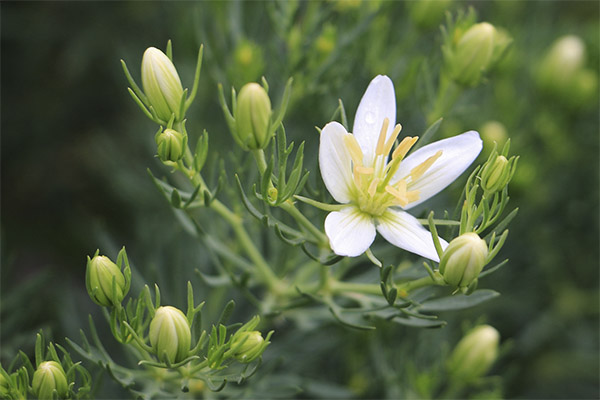
Infusion
With colds, myasthenia gravis, rheumatism and gynecological diseases, an infusion of a medicinal plant is indicated. To get it, you need to pour boiling water (1–1.5 cups) 1-2 tablespoons of dried harmonica. The composition should be infused for 50-60 minutes, then strain it, divide this daily rate into 3 servings and take 20 minutes before breakfast, lunch and dinner.
Tincture
On vodka
To prepare the alcohol tincture, take 100 grams of dried chopped harmonica and pour it into a glass bottle. Add there half a liter of good vodka and send to a dark place to insist for 3 weeks at room temperature. Shake the bottle from time to time.
Filter the finished tincture and take it in the mornings and evenings after eating. A single dose - a teaspoon, no more! Healers recommend this remedy to patients who are diagnosed with hypertension, neurasthenia, stroke, encephalitis, as well as suffering from epileptic seizures and schizophrenia. The spectrum of ailments in which tincture is indicated also includes venous congestion, bronchial asthma, diseases of the spleen, myasthenia gravis and inflammation of the sciatic nerve.
On the wine
Pour 100 grams of crushed seeds into a two-liter bottle filled with dry red wine. Shake and send to a dark room for a month. Do not forget to shake it daily.
After 30 days, strain and take it very little: you must not get carried away and forget that now it is not wine, but a serious, formidable medicine, and its overdose is unacceptable. The norm of admission is 25 drops before meals - from 2 to 3 times a day. Application - with the same problems as the tincture of vodka.
Decoction
A decoction prepared from harmala has a powerful antimicrobial effect, it shows good results when rinsing a sore throat or oral cavity with stomatitis, gingivitis or periodontal disease.
Boiling water (1 cup) pour a teaspoon of dried herb harmonica, close the lid tightly and keep for half an hour in a water bath. After cooling to a warm state, strain and use for the necessary procedures.
Butter
Plant oil is extracted in a very curious way. In the first days of spring, a small bush needs to be covered with an old leaky cauldron, a holey metal bucket or a damaged deep basin that is not needed in the household. Within a month, the entire vessel from the inside is covered with an oily sticky coating. It remains to scrape it off, put it in a jar, which is closed with a lid. Traditional healers believe that a plant that has survived in such a difficult atmosphere and has retained the desire for life can transmit this power to people.
Even the medieval Persian physician, Ibn Sina, treated this compound with sore joints and sciatic nerve inflammation in his patients, lubricating sore spots. And with problems with menstruation, urinary retention and various colitis, he not only used oil in the form of an ointment, but also made healing drinks on its basis.
Contraindications
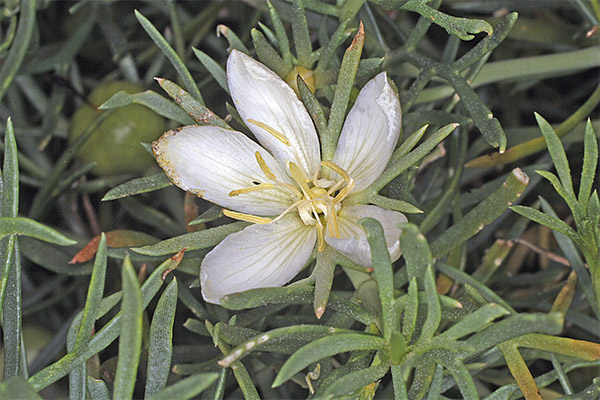
- Harmala is forbidden to people who have various kinds of tics, tremors and other hyperkinesis.
- You can not use formulations based on this plant for pregnant women and mothers who are breast-feeding a baby.
- Individual intolerance and hypersensitivity to the components of the grass are also a contraindication to its use.
Other people are not forbidden to take formulations from harmal. But we must not forget that this plant is poisonous, therefore, it is possible to use preparations prepared on its basis only with the exact observance of the recommended dosage. If it is exceeded, drowsiness and a decrease in temperature are possible, as well as more serious problems - depression, tachycardia, salivation, convulsions, convulsions, hallucinations, trembling, paralysis - up to respiratory arrest. If minimal such symptoms appear, you must definitely call an ambulance, and before her arrival, rinse the affected stomach.
If it is unreasonable to use funds based on a medicinal plant for a long time, it is likely that breathing problems, increased urination and disruption of the digestive tract.
It is unacceptable to be treated with harmala and at the same time consume alcoholic beverages. And if a person constantly takes some other medicines, it is necessary to discuss with your doctor how compatible they are with harmala.
«Important: all information on the site is provided exclusively in fact-finding purposes. Before applying any recommendations, consult with a profile specialist. Neither the editors nor the authors are liable for any possible harm caused materials. "

